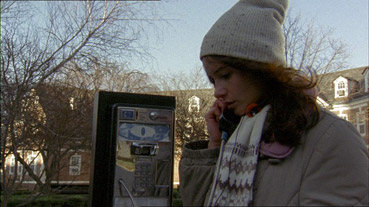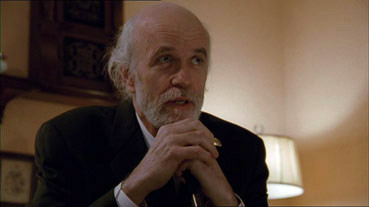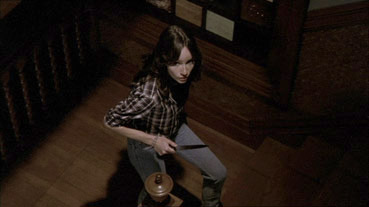"It's four-hundred dollars for four hours. It's too good to be true." |
"Did you ever think it IS to good to be true?" |
They don't make 'em like they used to. This is certainly true of horror movies, which have become noisier, slicker and a lot less scary in recent years. And they're always in a hurry. Back in the 70s and early 80s, these films were able to take their time building character and tension before unleashing the monsters and still be reasonably sure that the audience would stay with them. But the modern genre audience is perceived to have the attention span of a flea, and executives thus get twitchy about the concept of the gradual build and anxious about the size of any gaps between action scenes and manufactured scares. Ah yes, there are good reasons why many seasoned genre fans look back to earlier days with a sigh of nostalgia.
With just about every horror film from the 70s and 80s being regurgitated by the Hollywood remake machine, Ti West's 2009 The House of the Devil takes a different tack by attempting to recapture the mood, pace and feel of the North American horror works of the period. It's even set in 1983, which not only adds to the film's vintage feel, but negates the now obligatory need to disable mobile phones in order to convincingly isolate the characters.

The central figure is college student Samantha, who is desperate to move out of the dorm room she shares the disorganised and sexually over-active Heather. She's found an apartment that suits her perfectly, but while the kindly landlady (80s genre favourite Dee Wallace) is willing to waive the deposit, she does ask for the first month's rent in advance, money that Sam simply does not have. In need of some extra cash in a hurry, she answers an advertisement for a babysitting job and is told that her services will be required that very evening, but also that she will be financially recompensed for the inconvenience.
Now I should point out that by the time Sam arrives at the door of her employer's old and isolated house, which we can safely assume is the one of the title, we're half-an-hour into a 91-minute film and not all that much has actually happened. There's been a lot of walking, a few conversations, some scene setting and character building, but not much else, yet it's been consistently involving and the seeds for later developments have been quietly and effectively sewn. It's also given us time to bond with Samantha at a refreshingly unforced pace, not through some script-devised character trait or famous name casting, but because she's an ordinary girl with everyday problems and, as played by relative newcomer Jocelin Donahue, she's genuinely and unassumingly likeable. By the time she's being driven by her friend Megan to the house, we've formed enough of a bond to be concerned for her safety and to hope that she won't do anything to put herself in harm's way, despite knowing full well that she will.
Up until now, there's been only the smallest suggestion that the babysitting job might not be everything it seems – some peculiarities of communication and a voice on the phone that, while terribly polite, is just odd enough to suggest that maybe Sam should probably let this one go. But she needs the money badly and is not aware she's in a horror movie, so what possible harm could there be? She's not even that rattled when her employer Mr. Ulman's offbeat appearance lives up to the promise of his voice. She is just a little put out when it's revealed that it's not his children she's being asked to look after but his ageing mother, a simple case of keeping an ear out for problems while Ulman and his wife go out for a few hours to watch tonight's lunar eclipse. Megan smells a rat and we all know thats she's right, but Sam has by this point negotiated her fee up to $400, far more than she needs for that first month's rent. Go home, she tells Megan, I'll be fine, just pick me up later when my work is finished. So Megan gets into her car and departs, and...

...and it's just after this that our feet are suddenly kicked out from under us in one of the best and most genuinely unexpected jolts I've been given by a film for some time. A threat is established, but it's exact nature remains teasingly unclear. As Sam settles in, orders a pizza and wanders around the house, she remains unaware of the danger that lurks in the shadows and the likely threat to her safety. Having spent so long on his intriguingly low key build-up, West walks a fine line here between audience anticipation and potential impatience by extending the wait on the promise of the pay-off to come. Whether he crosses that line will be a matter of individual taste, and I'll admit to wondering a couple of times if the horror I could only presume we were building up to was going to be worth the wait, and to experiencing just a pang of disappointment when it turned out to pretty much what I'd suspected. Fortunately for all, compensation is provided the extended wind-up of the wait and the grisly panache with which the last act unfolds, squeezing real tension from sequences that should by right be dulled by familiarity.
The cast are uniformly impressive and provide their own share of specific delights. Chief amongst these are two quietly scene-stealing turns from old hands Tom Noonan and Mary Woronov as Mr. and Mrs. Ulman, both of whom deliver their dialogue with a delicious blend of friendly reassurance and subtle menace, making almost every line sound somehow loaded with hidden meaning. I've had a soft spot for Noonan for many years now, a stage actor of some repute whose imposing height and offbeat appearance have frequently seen him typecast in oddball roles, particularly following his extraordinary turn as serial killer Francis Dollarhyde in Manhunter. Noonan is an actor of unique precision and grace who too rarely lands the sort of roles his talent deserves – his performance as Sammy Barnathan and Charlie Kaufman's Synecdoche, New York was a rare and worthy recent exception. But I digress, and in doing so risk bypassing the crucial work done by Jocelin Donahue as Samantha, who as the only one on screen for a fair portion of the film is required to carry a good part of it on her shoulders, something she does with convincing aplomb. She even manages that rare trick of talking to herself without sounding like she's simply delivering information to the audience – her self-admonishing "get a grip" was apparently a favourite line with the preview audience.
On the commentary track, director West claims it was never his intention to make a homage to 80s horror, and while I'm not one to question his words, he makes such a complete job of it that it really is hard to accept this as true. The period feel is immaculate, from the fashions and hairstyles to Jeff Grace's subtly unsettling score and Eliot Rockett's pitch-perfect lighting camerawork, whose angled shots, following pans, short tracks and slow zooms give way to more energised hand-held work only when the pace dictates. Honestly, if you didn't know in advance, you'd swear you'd stumbled on a lost genre piece from that period, despite a climax that owes more to late 60s and early 70s Hammer than to the more creature oriented horrors of the early 80s.

Whether the film's prime audience will prove to be older genre fans who are nostalgic for the sort of restraint and slow build employed here is anybody's guess, but it would be nice to think those raised on the more recent action and gore-driven works might also give it a go, and that just maybe they'd be intrigued enough by its unhurried pace and confident way with character and suspense to check out some of the films that inspired it. Either way, The House of the Devil is a quietly involving and for the most part refreshing throwback to the genre's earlier days – I'd have been more excited if it taken us somewhere we'd not been before, but I still thoroughly enjoyed the ride.
Although shot on Super-16, the image has a very authentic early-80s quality, having the definition and grain of higher speed 35mm of the period and an appropriately toned down colour palette, the combination of precise set dressing and colour timing giving much of the image an earthy brown/green look, particularly at night. Contrast is well balanced and the lighting assures that key picture detail remains clear even when light levels really drop.
You can choose either Dolby 2.0 or Dolby 5.1 surround tracks and there's not a huge difference between them, with the action and dialogue located almost exclusively front and centre and the surrounds reserved for the music, which sounds a tad fuller on the 5.1 (conversely the dialogue seems to have slightly more volume on the 2.0 track). Both are clear and boast a very reasonable dynamic range.
Commentary by writer-director-editor Ti West and actress Jocelin Donahue
A trip down recent memory lane for West and Donaghue, who recall their experience of working on the film, with each other and the other actors, particularly Dee Wallace and Tom Noonan. West provides detail on the music, locations, costumes, sound effects and set decoration, and points out the details that were drawn from his own experience. I was amused to hear that the shooting title was simply 'The House' due to the filmmakers' concern that some of those lending support to the production would be put off by the word 'devil'.
Commentary with writer-director-editor Ti West, producers Larry Fessenden and Peter Phok, and sound designer Graham Reznick
Despite some crossover with the above, this is a lively and mirth-spattered commentary with some good-natured piss-taking, particularly by the sometimes theatrically voiced Fessenden. It also reveals quite a bit about the making of this low-budget film, from the use of eBay to locate period props to the technical specifications of set decoration, music, sound design, lighting and camerawork. It includes a brief but interesting discussion on the sort of lingering character moments that you just don't find in the genre any more and what horror movies seem to have lost in recent years.
In the House of the Devil (13:33)
A decently shot and edited collection of behind-the-scenes DV footage of the shoot, backed by a pounding heartbeat track.
Deleted Scenes (6:57)
Three unedited shots, two involving alternative sides of a phone call between Sam and Megan, plus a short sequence involving Ulman's mother. Samantha's end of the phone call is covered in a continuous 360 degree rotating shot that could have come straight from early De Palma.
Trailer (2:08)
A solid sell, but there are a couple of giveaways that are best avoided before the first viewing of the film.
The House of the Devil is gaining a bit of a rep with fans and critics alike, and it's not hard to see why. In some respects it plays as a technical exercise, an attempt to recreate the look and feel of late 70s and early 80s horror works without substantially altering or developing any aspect of the formula. But within this confine, director West and his talented cast and crew do a bang-up job of telling an old school horror-suspense story, and the film's warm reception probably says as much about the general weariness with modern American genre works as it does about the endearing quality of some of those earlier films. A very decent disc from Metrodome makes it well worth the purchase price.
|